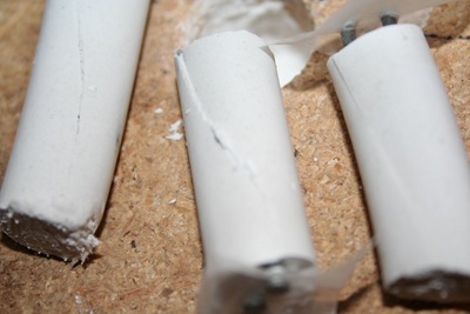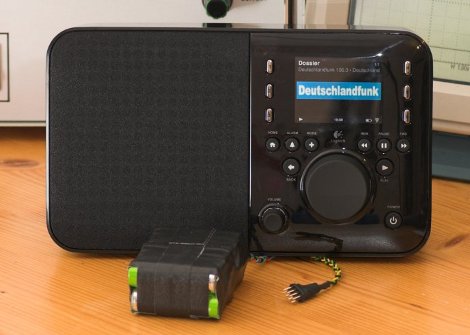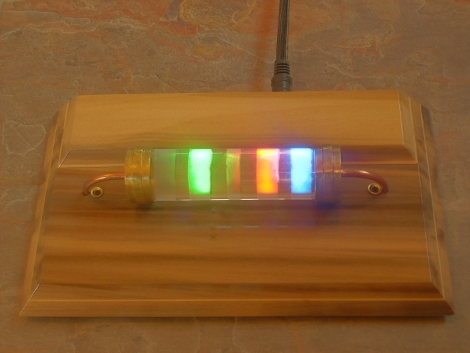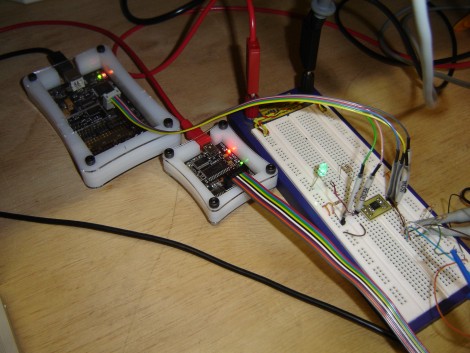[Stewart Allen] acquired a Mindstorm kit about a month ago and he’s already building his own sensors for it. He wanted a more accurate range finder with a narrower measurement field than the stock sensor. Mindstorm has the option to communicate with sensors via an I2C bus. [Stewart] set up an ATtiny45 to act as a the slave on the bus, facilitating the analog measurement of the distance voltage by using and lookup table, and handling the data transfer with the NXT brick. His testing setup is pictured above, with an AVR Dragon for programming the tiny45 and a Bus Pirate for sniffing the I2C data during the development process. The sensor, looking great on a professionally made PCB he ordered, requires a simple driver that [Stewart] hammered out for use with leJOS, the alternative Mindstorm firmware we’ve seen before.
sensor253 Articles
Wine Cask Sensor Suite

As part of his Master’s dissertation [Salvador Faria] built a sensor suite for wine monitoring. He needed to develop a method of tracking data inside the wine cask during the vinification process. What he came up with eclipses the wine cellar temperature monitors we’ve seen before.
He picked up pH, temperature, carbon dioxide, alcohol, and relative humidity sensors from familiar vendors like Seeed, Parallax, and SparkFun. His original idea was to develop a floating probe that housed the entire package but he had quite a bit of trouble getting everything inside and maintaining buoyancy. The solution was a two-part probe; the stationary portion seen mounted on top of the cask houses the microcontroller, RF 433 MHz transmitter, and the gas sensors. Tethered to that is a floating probe that measures pH and temperature. Data is sent over radio frequency to an HTTP POST server every minute.
Keep Tabs On Your Car Without OBD-II

[Steve] let us know about his MultiDisplay car monitoring system. Unlike traditional systems that rely on interfacing with the OBD-II protocol and existing car computer, the MultiDisplay uses an Arduino and custom shield with a combination of sensors; including temperatures, pressures, throttle, Boost, and etc. The data collected can then be displayed on a 20×4 LCD or streamed to a PC with visualization and event recording.
It’s nice to see half a years worth of work finally be complete and presented in such a clean and professional manner, keep up the good work [Steve]
Soil Moisture Sensing

These plugs are cheap, easy to make, and work well for measuring the moisture content of soil. The Cheap Vegetable Gardener came up with this method in order to add automatic watering to an automated grow system. Plastic tubing is used as a mold for Plaster of Paris. Once the plaster has been poured, two galvanized nails are inserted. These are won’t rust and work as probes, measuring the resistance of the dried plaster (gypsum). When inserted into the soil, the moisture content within the gypsum will fluctuate along with the soil. As moisture rises, the resistance between the probes falls, which can be monitored by a microcontroller and used to trigger or stop a watering system.
[Thanks Juan]
Portable Squeezebox With Serial

The Squeezbox media streaming systems are compact Linux WiFi enabled radios that let you stream your collection anywhere,so long as you have an AC or USB outlet nearby. But [Achim Sack] wanted to stream his collection from anywhere with no wires attached (translation). Some poking and prodding revealed a connector actually designed for a battery and serial, but no commercially available battery yet.
The system requires a temperature sensor and if you want serial, a USB converter, but overall a simple process that could be done in an afternoon. Giving your box ~10 hour of life and even fits inside of a back compartment.
[Thanks Thomas]
Know Your Resistors… Tell The Time

[Darren] built a clock that uses a resistor to display the time. Well, it really uses a model of a resistor. This extremely tardy entry in the Hackaday design challenge houses all of the electronics on a PCB the size of a business card. Four RGB LEDs shine up through holes in the wooden base to light bands on an acrylic tube. The colors correspond to the values used in the Resistor Color Code. In the picture above the clock is displaying 5:26 (that’s supposed to be a red band but the camera didn’t pick it up too well). The band in the center fades up over 60 seconds to signify AM, and down to show PM.
It may be late, but it’s a clever design. It looks sleek and it uses no buttons for an interface. [Darren] sourced the LEDs themselves as light sensors to display the date, and enter time setting mode.
Capturing Bullet Speed

Sometimes it’s amazing how slow our sense of time is. We find [Maurice’s] bullet capture system a great example of this. A pair of IR sensors spaced two inches apart can capture and calculate the speed of a projectile. Couple this with a user-input distance from the sensor to the target and a microcontroller can extrapolate the exact moment to trigger a camera to catch a bullet in mid-air.
As with his other projects, all the details on how to build and use this system are available for your perusal.











